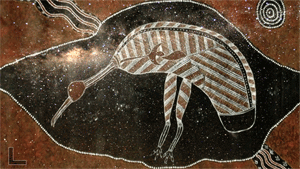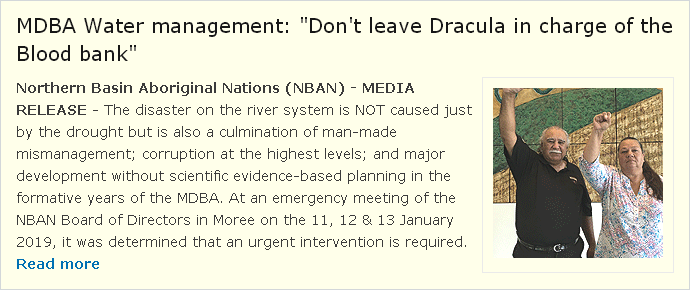First Nations are Water Owners, Not Stakeholders
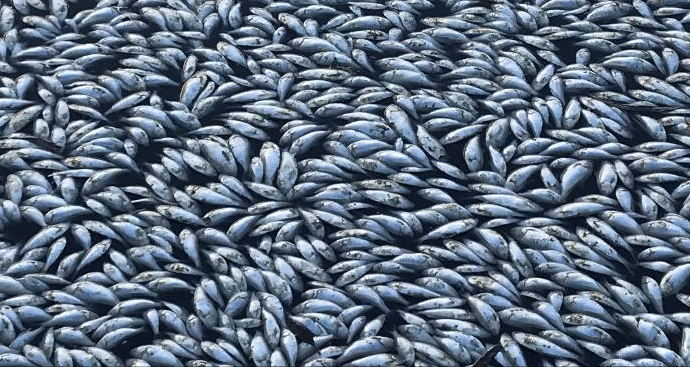

Ghillar, Michael Anderson 30 January 2019
not just stakeholders
To date First Nations Peoples have merely been seen as stakeholders with certain, but very limited, rights in having a say about water planning and management in the Murray-Darling Basin. But when we look at the Mabo judgement, we must understand the nature of our true status in this landscape. I will repeat what I've said in other statements:
At paragraph 65 in the Mabo Case the High Court ruled:
65. Native title, though recognized by the common law, is not an institution of the common law and is not alienable by the common law.
In other words, First Nations and Peoples have a common law right to all the water, surface and groundwater, in the colonial legal system. Our rights to water have never been extinguished by the colonisers, even though its management has been usurped and operates on a greed-based system promoted by irrigators and mining companies, whereas our Law and culture demands Respect for all the members, the lands and waters of First Nations downstream.
Couple this with our spiritual ties and responsibilities to our water spirits (by whatever name they are known) throughout the Murray-Darling Basin, including the associated water sites, springs and waterholes, where our ancient water spirits travel and rest. The spiritual connections are what provide for the survival of our water species, fish, crustacea and shellfish in extreme climate events. There is no question that in the past we have been impacted on by droughts, because they are a natural phenomenon.
The Northern Basin Aboriginal Nations (NBAN) Treaty was agreed between the First Nations of the Northern Murray Darling Basin to claw-back water flows to meet our responsibilities for Cultural Flows, and the spiritual and physical health of our waterways. Reference: NBAN Treaty
Our problem now, which exacerbates the situation, is man-made interference, e.g. dams, weirs, water diversion channels for cotton farms and other irrigation; pollution from feedlots; cotton defoliants that kill fish and other aquatic life; failed monitoring and compliance of water extraction and diversion; over-allocation of the scarce water resource in low flow and drought times; permitted expansion of intake pipes from 10cm to 60+cm; release of deoxygenated water from lower levels of dams; too fast speed releases of dam water which erodes riverbanks and exposes the roots of River Red Gums, many of which fall into rivers; corporate irrigators in charge of water allocations; blue-green algae (cyanobacteria) toxins; environmental water licence buybacks controlled by the Commonwealth Department of Agriculture and Water Resources; environmental water allocation is too small to be properly effective.
The overall dollar figure for water buybacks for environmental flows does not reflect the real water available for environmental flows.
Let me cite an example.
When Euahlayi Nation representatives asked the Commonwealth Environmental Water Office (CEWO) how much Commonwealth environmental water is held in Beardmore Dam above St George in Queensland on the Balonne River, which feeds the three named rivers, including the Narran Lakes, we were informed by the Murray-Darling Basin Authority (MDBA) that the Commonwealth environmental water allocation is 40ML in the Beardmore Dam. In no way can a release of 40ML meet the total water requirement to fill the Narran Lakes, a Ramsar registered ecosystem, let alone feed the rivers mentioned. So where did the $25 million of water go?
First, we need to explain the importance of a Ramsar site, which is a wetland of international significance and is protected under international law by the Ramsar Convention, which Australia has ratified. Ramsar
Narran Lakes is part of the heartland of our Euahlayi Nation and is a Ramsar-listed wetland, vital for migratory waterbirds which fly from the northern hemisphere to feed and breed at Narran Lakes. It is a crucial link in their flyway.
![]() Waterbird Breeding indicators Narran Lakes pdf
Waterbird Breeding indicators Narran Lakes pdf
![]() Narran Lake Nature Reserve Ramsar Site pdf
Narran Lake Nature Reserve Ramsar Site pdf
![]() Narran Lake Nature Reserve Ramsar Site Ecological Character Description pdf
Narran Lake Nature Reserve Ramsar Site Ecological Character Description pdf
But due to mismanagement, Narran Lakes has been dry for over five years, revealing a lakebed of cracked dry mud, even though I worked with water managers to determine at what level Narran Lakes needs to be for successful waterbird-breeding and for how long this level needs to be maintained. We are currently advocating for Cultural Flows to replenish Narran Lakes and other important cultural sites. Narran Lake holds a vital role in the core of Euahlayi Creation Stories and is central to our cultural knowledge.
Australia has also signed other international conventions to protect migratory waterbirds which depend on a viable chain of wetlands in order to maintain their migrations from the northern to southern hemisphere and vice-versa, e.g. CAMBA, the China-Australia Migratory Bird Agreement and JAMBA, the Japan-Australia Migratory Bird Agreement.
It should be noted that the Constitution of Australia prevented the Commonwealth from water planning processes within the States. The way the Commonwealth gained a legal right to intervene in the water planning process was to bring in the Ramsar, CAMBA, JAMBA and the Biodiversity Conventions, all of which precluded the Commonwealth from privatising water, as in the Constitution. They did this through the External Powers of Section 51(29) of the Constitution.
I might remind our readers that the Commonwealth's responsibility is to ensure sufficient water was made available to sustain the natural ecosystems, through ensuring sufficient flows on a regular basis. Clearly, the MDBA has been infiltrated by economists and irrigators to ensure the bottom line for corporate developers, instead of sustainable river systems to maintain the country's health.
The constitution does permit the Commonwealth now to claw back water allocations because they need to determine what constitutes 'reasonable use': It can be argued that The Australian Constitution does give the Commonwealth power over the unreasonable use of waters at Section 100:
The Commonwealth shall not, by any law or regulation of trade or commerce, abridge the right of a State or of the residents therein to the reasonable use of the waters of rivers for conservation or irrigation.
The lesson gained from my inquiries as to where the $25 millions worth of environmental water disappeared to, revealed that most of the water buyback is for floodplain harvesting of that rainfall. In a drought the water is illusory. Thus the $25 million was for an 'empty bucket' at taxpayers' expense. This bucket not only has a hole in it, but in the last 7 years has never had any water at all in it!
This 'empty bucket' water buyback cost is then added to the quoted millions of dollars buyback by the Department of Agriculture and Water Resources. We can say that 40ML is not worth $25 million! But when they add the sum of buybacks in the northern basin, there is no true representation of actual real water recovered. It is merely a figure attached to the total sum of money spent. A trained accountant would be asking questions: If there is no actual water associated with these buybacks, why then would you spend so much from the public purse?
It's an illusion-now we see it (on paper), now we don't see it (as real water).
The now infamous Cubbie Station, which is 80 per cent Chinese-owned, is licenced to take 460 billion litres (460 Gigalitres) of water from the Culgoa River every year. The Culgoa should flow into the Darling River but a weir prevents this and instead backs up the water so that it can flow through channels to Cubbie Station.
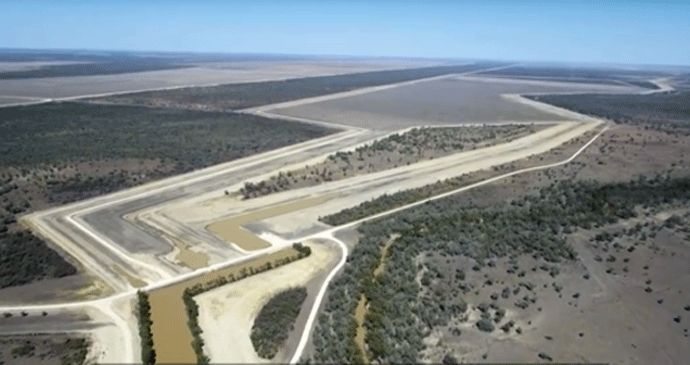
Cubbie Station: 28 km of dams irrigate 130 square kms of cotton. The station is licensed to take 460,000 megalitres the equivalent of all irrigation entitlements downstream in north-western NSW. The water-starved Culgoa River is to the right of the water channel.
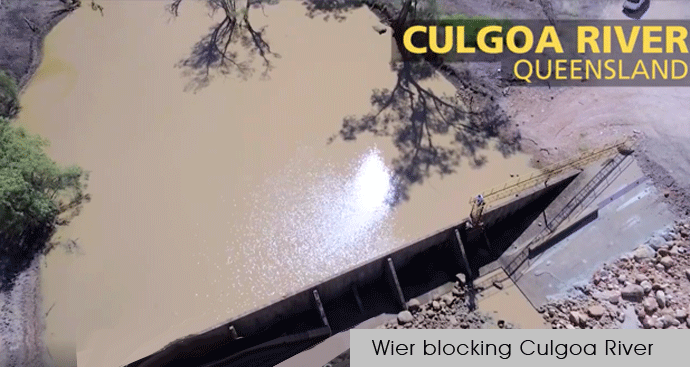
Construction of a weir which blocks the Culgoa River and diverts the river into Cubbie Station. The Culgoa should flow into the Darling River. Photos: Jeremy Buckingham

Lock gates on Cubbie Station divert water from the Culgoa River to holding dams. The quantity of water diverted was never measured because technically it was not 'pumped'. Photo: Eleanor Gilbert
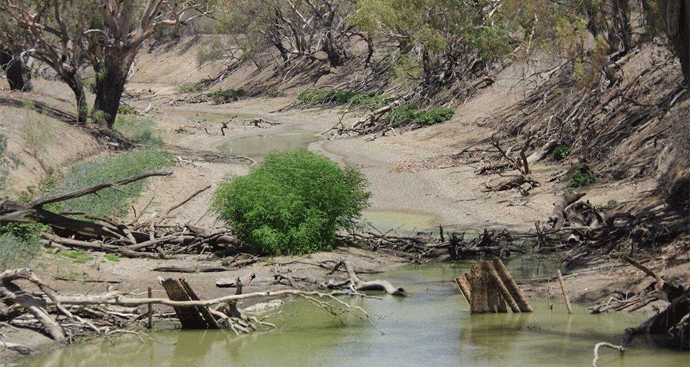
Namoi and Barwon Rivers at Walgett at their Juction - Barwon River Weir
(Image Dharriwaa Elders Group - Facebook 16 February, 2019)
The cumulative impacts that now further complicate the natural ecosystem is the granting of rights and issuing of water licences to erect bunding levees for floodplain harvesting of rainfall.
Believe it or not, the State governments have created a water licence for this floodplain harvesting when rain falls from the sky over these floodplains. We have never been informed as to what licence type these floodplain harvesting events fall into. This is what is referred to as 'sustainable diversion limits'.
![]() ABCS Floodplan story Misleading, Government claims Northern Daily Leader
ABCS Floodplan story Misleading, Government claims Northern Daily Leader
![]() NSW Water Policy ABC
NSW Water Policy ABC
![]() Floodplain Harvesting Overland Flows MDBA (Government)
Floodplain Harvesting Overland Flows MDBA (Government)
We do know that they are worth a lot of money when the Commonwealth Department of Agriculture and Water Resources, now under Minister Littleproud, buys back the licences. Unfortunately for the public they are informed of the extent of the millions of dollars being spent to buy back water licences, but they are not told that 'empty buckets' are being bought back. This is "money for the mates" at taxpayers' expense.
Ironically, it is Minister Littleproud's wife's cousin, John Norman, who owns Norman Farming near Goondiwindi and is in court for fraud, along with his Chief Financial Officer, Stephen Evans. Norman Farming used a $31 million 'water efficiency' grant to construct 50kms of levees and:
under the conditions set by Queensland's Department of Natural Resources, Mines and Energy there was virtually no checking of the projects during, or after completion
Lamey and other neighbours have accused the irrigator of illegally constructing more than 50km of levees and banks on his massive farming operation. They say the levees have caught and diverted large volumes of floodwaters from the McIntyre River into Norman Farming's expanded on-farm storage dams.
Queensland cotton farmer charged with 20m murray darling-plan The Guardian
Currently, the Commonwealth Environmental Water Office (CEWO) only has 0.5 Gigalitres of water left in the Gunidgera Weir near Wee Waa in New South Wales; 5.5GL was released beginning on 9 November 2018 to replenish fish waterhole refuges in the Namoi River, which has ceased to flow. CEWO is cautious about releasing environmental water when crops are growing for fear of it being diverted for irrigation.
![]() PC Report into Murray Darling Basin Plan pdf
PC Report into Murray Darling Basin Plan pdf
![]() Basin Plan Drraft Overview pdf
Basin Plan Drraft Overview pdf

The Euahlayi warn our fellow brother and sister Nations to be aware of the slow, but sure, movement of these corporate cotton growers from the Northern Basin to lease land of First Nations Peoples well above the Tropic of Capricorn e.g. in the Kimberley and around Katherine and beyond.
I urge these First Nations Peoples in Western Australia and the Northern Territory to first have a look at the massive land clearances in the Murray-Darling Basin for cotton farming, before they enter into any deals. Money will not replace the vegetation that the people in the north will stand to lose. The pristine and beautiful land of the north will be turned into massive open fields of monoculture, just for the sake of the bottom line of Australian consortiums e.g. Webster group from Tasmania and some transnational corporations.
Any Commonwealth Government Royal Commission being proposed must include a forensic auditing of the water buyback program of the Federal Minister's Office and the Department of Agriculture and Water Resources. It must also include Commonwealth funding for water efficiency projects, and the ability to recommend prosecutions if there have been wrongdoings. The Northern Basin Aboriginal Nations (NBAN) has already floated this idea with Sarah Hanson-Young's Office. (NB: The Commonwealth took out an injunction to prevent the MDBA staff from giving evidence to the State SA Royal Commission.)
If people investigate what this water buyback program represents, they will realise it is the biggest scam- the accumulation of public monies for a few. Pablo Escobar (1949-1993), the former big drug lord of Columbia, if he could read what is going on here in Australia with water buybacks, would have been totally envious of how the public purse is being 'legally' stripped under the biggest financial scam of all time.
The National Party boys devised this water management scheme under John Howard courtesy of John Anderson, former Nationals Deputy PM. The public must know that any and all portfolios associated with agriculture, water, land development, environment etc. are given to members of the National Party, the farmers' boys, who have a clear vested interest. They win the hearts and minds of the city-based public by claiming: We feed you and when feeding you is no longer profitable we'll take from your taxes to subsidise our losses. A clever scam indeed.
By being at the table of some of these recent water meetings it is easier to work out what is going wrong, while First Nations Peoples and the working class do not have any type of collateral that can be bargained for millions of dollars. Admittedly there are farming families, who deal primarily with sheep and cattle grazing, who are also hurting more than the cotton growers, and also they don't have "empty buckets" to sell.
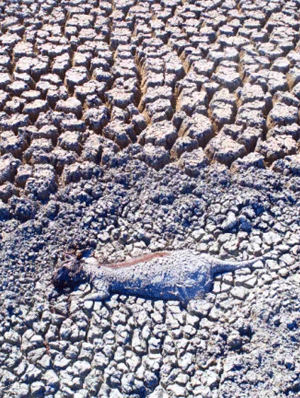
The malaise of 'solastalgia' is prevalent, a form of psychic pain, mental or existential distress caused by environmental change, coupled with perceived powerlessness to make a difference.
I am aware of suicides in these families, mental illness and depression, just like among First Nations Peoples, who are witnessing land degradation on a scale not equalled anywhere in the world.
The malaise of 'solastalgia' is prevalent, a form of psychic pain, mental or existential distress caused by environmental change, coupled with perceived powerlessness to make a difference.
The withdrawal of proper services e.g. doctors, dentists etc. is significantly impacting on First Nations Peoples and the working class, and is resulting in the slow population decline in in rural and remote areas.
The scorched earth policy of the colonialists continues unabated and the corporates' desire to be the only ones operating along these rivers will become a reality under the current system, if it is not addressed now. First Nations Peoples have already experienced this when they shut down our communities in our homelands This is now an attack on mainstream communities as well.
In the stakeholders' meeting chaired by MDBA CEO, Phil Glyde, on 23 January 2019, First Nations representatives from Murray Lower Darling Rivers Indigenous Nations (MLDRIN) and NBAN were at least asked to speak first. A small positive step, but the stakeholders' meeting achieved little progress. I was, however, able to inform the meeting that as First Nations are owners not stakeholders, we are preparing a High Court case over water ownership.
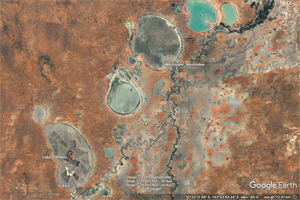
CLICK TO ENLARGE
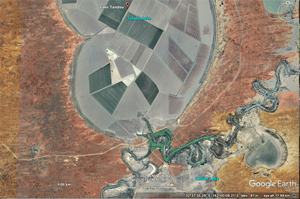 CLICK TO ENLARGE
CLICK TO ENLARGE
2019 Google Earth image of Tandou Lake/Station - once a lake, once a wetland. It's clear to see there is still plenty of water in the irrigation channels in 2019 for the cotton crop!
An example of how totally pear-shaped environmental water management is in the Murray Darling Basin is the Tandou Story. We heard from the representative for the Minister of Agriculture and Water Resources about Tandou Station, which was bought in 2015 by Webster, who was paid $78 million in 2017 for the 21.9 billion litre (21.9GL) water licence; was also paid to decommission the irrigation and never irrigate again. Additionally, Webster was never charged for final year of water allocations.
Significantly, Webster was able to keep water for an extra year and as a result we were told at the Stakeholders' Meeting (23/1) that he had a 'bumper crop this year' and is 'putting another in.' There are allegations that he captured water from the environmental release from Menindee Lake. The release, which is part of the complex reasons for the massive fish deaths, was explained as a way to reduce evaporation because of the shallowness of water on the edge of Menindee Lake and would go towards WaterNSW's water efficiency target.
![]() Tandou to sell water entitlements, convert NSW farm to lamb business ABC
Tandou to sell water entitlements, convert NSW farm to lamb business ABC
![]() Company allowed to keep water for extra year after Darling buyback The Guardian
Company allowed to keep water for extra year after Darling buyback The Guardian
The MDBA Director of Operations was asked why water was released in 2016/17 from Menindee Lakes when it was not needed by the environment, because there had already been a big flood in the Murray River. She explained that it was a 'peaky' flood that moved fast and in January demands came quickly and they were obligated to deliver an Additional Diversion Flow (ADF).
No doubt the South Australian Murray-Darling Basin Royal Commission's findings, which are now being released to the public, will have more tales to tell.
 Contact: Ghillar Michael Anderson
Contact: Ghillar Michael AndersonConvenor of the Sovereign Union,
Head of State of the Euahlayi Peoples Republic
Contact Details here
True Tales of the Trout Cod: River Histories of the Murray-Darling Basin. by Will Trueman


